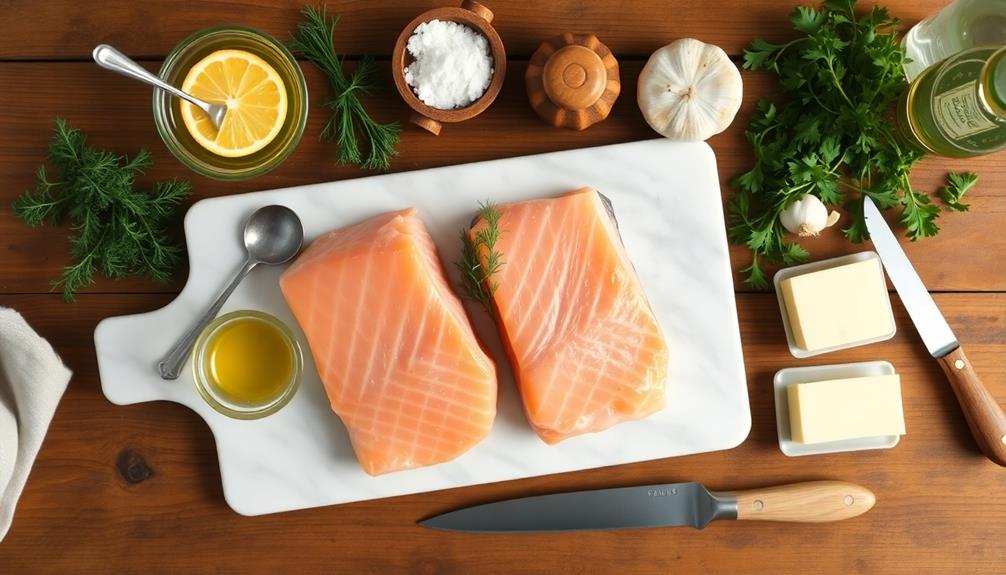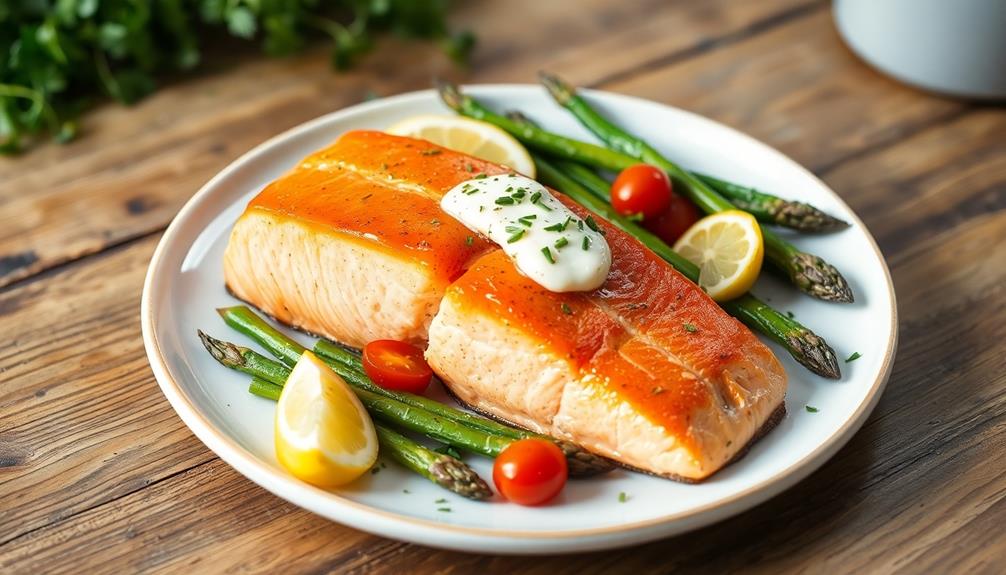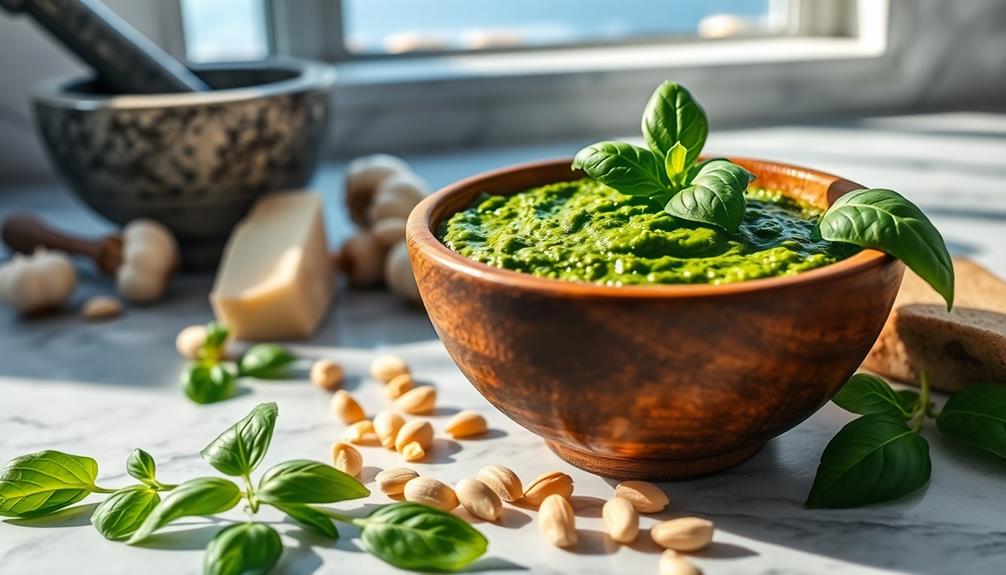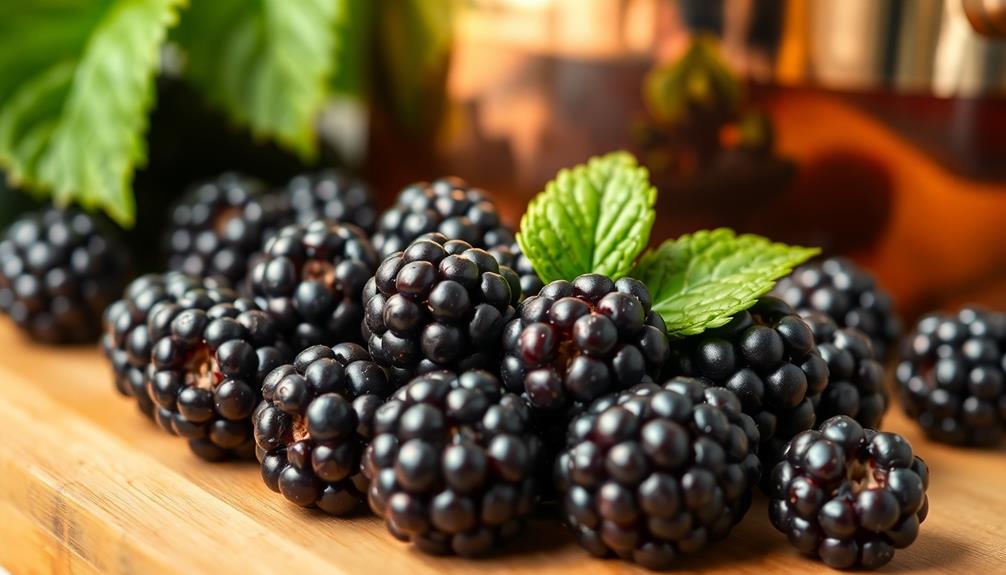Wild-caught salmon with herb butter is a delicious and healthy dish you'll love. Start by patting your salmon fillets dry and seasoning them with sea salt. Cook them skin-side down in a hot skillet for 4-5 minutes, then flip and cook for another 2-3 minutes. While the salmon cooks, mix softened butter with fresh herbs like dill and parsley, adding lemon zest and a pinch of salt. Top your cooked salmon with slices of this flavorful herb butter, letting it melt into a savory sauce. This simple recipe highlights the rich taste of wild-caught salmon while providing essential nutrients. There's more to discover about this versatile and nutritious seafood option.
Key Takeaways
- Wild-caught salmon offers superior flavor and nutritional benefits compared to farmed varieties.
- Herb butter enhances salmon's taste with a blend of fresh herbs, lemon zest, and salt.
- Cook salmon skin-side down first for crispy skin, then flip to finish cooking.
- Aim for an internal temperature of 145°F (63°C) for perfectly cooked salmon.
- Top cooked salmon with sliced herb butter, allowing it to melt into a flavorful sauce.
History
The history of wild-caught salmon dates back thousands of years. You'll find that Native American tribes were among the first to master salmon fishing techniques. They'd use spears, nets, and traps to catch these prized fish in rivers and coastal waters.
Salmon wasn't just food; it played a crucial role in their culture and ceremonies.
As European settlers arrived in North America, they quickly recognized the value of wild salmon. Commercial fishing began in the 19th century, with canneries popping up along the coasts. This led to a boom in the salmon industry, but it also raised concerns about overfishing.
Today, you'll see strict regulations in place to protect wild salmon populations. Fisheries use sustainable practices to ensure these fish continue to thrive.
When you buy wild-caught salmon, you're participating in a long tradition of respectful harvesting. The methods have evolved, but the appreciation for this delicious and nutritious fish remains.
From ancient fishing techniques to modern conservation efforts, wild-caught salmon continues to be an important part of our culinary heritage.
Recipe
Wild-caught salmon is a delicacy prized for its rich flavor and numerous health benefits. This recipe showcases the natural taste of the fish while complementing it with simple, fresh ingredients that enhance its inherent qualities.
This dish is perfect for a special dinner or a healthy weeknight meal. The combination of lemon, herbs, and garlic creates a bright and zesty flavor profile that pairs beautifully with the salmon's natural oils. The cooking method ensures a tender, flaky texture while maintaining the fish's moisture.
- 2 wild-caught salmon fillets (6-8 oz each)
- 2 tablespoons olive oil
- 1 lemon, sliced
- 2 cloves garlic, minced
- 1 tablespoon fresh dill, chopped
- 1 tablespoon fresh parsley, chopped
- Salt and freshly ground black pepper to taste
- 1/4 cup white wine (optional)
Preheat the oven to 400°F (200°C). Pat the salmon fillets dry with paper towels and place them in a baking dish. Drizzle olive oil over the fillets and season with salt and pepper. Sprinkle minced garlic, dill, and parsley over the fish. Arrange lemon slices on top and around the fillets. If using, pour white wine into the baking dish. Bake for 12-15 minutes, or until the salmon is cooked through and flakes easily with a fork.
For best results, choose salmon fillets of equal thickness to ensure even cooking. If you prefer a crispy skin, start by searing the salmon skin-side down in a hot, oven-safe skillet for 3-4 minutes before transferring to the oven to finish cooking.
Remember that wild-caught salmon tends to be leaner than farmed varieties, so be careful not to overcook it, as it can dry out quickly.
Cooking Steps
To cook wild-caught salmon perfectly, you'll need to follow a few key steps.
First, prepare a flavorful herb butter mixture and season your salmon fillet with salt.
Then, cook the salmon skin-side down in a hot pan, flip it to finish cooking, and top it with the herb butter for a delicious finish.
Step 1. Prepare Herb Butter Mixture

Preparing a flavorful herb butter mixture is crucial for enhancing your wild-caught salmon. To start, you'll need softened unsalted butter, fresh herbs, lemon zest, and a pinch of salt. Choose herbs like dill, parsley, or chives for a classic flavor combination.
In a small bowl, mix the softened butter with finely chopped herbs. Add a teaspoon of lemon zest and a pinch of salt to brighten the flavors. Use a fork to blend everything together until it's well combined.
Taste the mixture and adjust the seasoning if needed. Once you're happy with the flavor, you can shape the herb butter into a log. Place it on a piece of plastic wrap, roll it up tightly, and twist the ends to seal.
Pop it in the fridge for about 30 minutes to firm up. This step makes it easier to slice later. When you're ready to use the herb butter, simply cut off thin rounds and place them on top of your cooked salmon.
The heat from the fish will melt the butter, creating a delicious sauce that adds moisture and flavor to your dish.
Step 2. Season Salmon With Salt

With your herb butter ready, it's time to focus on the salmon itself. The next step is to season your wild-caught salmon with salt. This simple yet crucial step will enhance the fish's natural flavors and help create a delicious crust when cooking.
Start by patting the salmon fillets dry with paper towels. This removes excess moisture, allowing the salt to stick better and promoting even seasoning.
Next, sprinkle a generous amount of sea salt or kosher salt over both sides of each fillet. Don't be shy with the salt – salmon can handle it well. As you season, gently press the salt into the flesh to ensure it adheres properly.
Step 3. Cook Salmon Skin-Side Down

In light of the previous steps, it's time to cook your perfectly seasoned salmon.
Place a non-stick skillet over medium-high heat and add a touch of oil. Once the pan is hot, carefully lay your salmon fillet in the skillet, skin-side down. This method ensures that the skin gets crispy and delicious.
Don't be tempted to move the salmon around. Let it cook undisturbed for about 4-5 minutes, depending on its thickness. You'll notice the flesh starting to change color from the bottom up.
When about two-thirds of the fillet has turned opaque, it's time to flip. Using a spatula, gently turn the salmon over. Cook for another 2-3 minutes on the other side. The center should still be slightly pink and translucent – that's how you know it's perfectly cooked and not dried out.
Step 4. Flip Salmon to Finish Cooking

The moment of truth arrives as you prepare to flip your salmon. After cooking skin-side down for about 4-5 minutes, it's time to turn the fillet over. Gently slide a spatula under the salmon, making sure it's not sticking to the pan. With a swift, confident motion, flip the fish onto its other side.
You'll notice the cooked side is now a beautiful golden-brown color. The flesh should be opaque about halfway up the sides. Now, cook the salmon for another 2-3 minutes on this side. This final cooking step ensures the fish is evenly cooked throughout.
Keep a close eye on your salmon during this last stage. You don't want to overcook it, as it can quickly become dry. Look for signs that it's done: the flesh should flake easily with a fork, and the center should be slightly translucent.
If you're unsure, use a meat thermometer. The internal temperature should reach 145°F (63°C) for fully cooked salmon. Once it's done, remove it from the heat and let it rest for a minute before serving.
Step 5. Top With Herb Butter

Ready to elevate your perfectly cooked salmon? It's time to add a burst of flavor with herb butter. This simple yet delicious topping will take your wild-caught salmon to the next level.
First, you'll need to prepare the herb butter. In a small bowl, mix softened butter with finely chopped fresh herbs like dill, parsley, and chives. Add a squeeze of lemon juice, salt, and pepper to taste. Stir until everything's well combined.
Now, take your hot, freshly cooked salmon and place it on a serving plate. Using a spoon, carefully dollop small amounts of the herb butter on top of the fish. You'll see it start to melt immediately, creating a fragrant and flavorful coating.
As the butter melts, it'll mix with the natural juices of the salmon, creating a delicious sauce. The herbs will release their aromatic oils, infusing the fish with their fresh flavors.
This simple addition not only enhances the taste but also adds a beautiful, appetizing appearance to your dish.
Final Thoughts
Wild-caught salmon stands as a nutritional powerhouse and environmental bellwether. When you choose this fish, you're not just getting a delicious meal, but also supporting sustainable fishing practices.
Remember, the quality of your salmon matters. Look for bright, firm flesh and a fresh ocean scent when shopping.
As you've learned, preparing wild-caught salmon with herb butter is a simple yet elegant way to enjoy this fantastic fish. The herb butter adds a burst of flavor that complements the salmon's natural taste.
Don't be afraid to experiment with different herb combinations to find your favorite.
Cooking salmon doesn't have to be complicated. Whether you grill, bake, or pan-sear, the key isn't to overcook it. A perfectly cooked salmon should be moist and flake easily with a fork.
If you're unsure, it's better to undercook slightly than overcook, as you can always cook it a bit more.
Lastly, remember that wild-caught salmon is versatile. You can use leftovers in salads, sandwiches, or even breakfast dishes.
Enjoy your culinary adventure with this amazing fish!
Frequently Asked Questions
Is Wild-Caught Salmon Healthier Than Farmed Salmon?
Yes, wild-caught salmon is generally healthier than farmed salmon. You'll find it's richer in omega-3s and has fewer contaminants. It's also more sustainable. However, farmed salmon can still be a nutritious choice if wild-caught isn't available.
How Can I Tell if Salmon Is Truly Wild-Caught?
You can tell if salmon's truly wild-caught by checking its label, color, and price. Look for "wild" or "Alaskan" on packaging. Wild salmon's typically darker and more expensive. Ask your fishmonger about its origin and fishing method.
What's the Best Wine Pairing for Wild-Caught Salmon With Herb Butter?
You'll want a wine that complements the rich flavors of wild-caught salmon with herb butter. Try a crisp Chardonnay or Sauvignon Blanc. If you prefer red, opt for a light Pinot Noir. Don't forget to chill your white!
Can I Substitute Other Fish for Wild-Caught Salmon in This Recipe?
You can substitute other fish for wild-caught salmon. Try using halibut, cod, or sea bass. They'll work well with herb butter. Remember to adjust cooking times based on the fish's thickness and texture for the best results. If you’re looking for a fresh fish recipe, consider using wild-caught salmon as it is rich in omega-3 fatty acids and has a delicious, robust flavor. However, if you want to change things up, feel free to experiment with different types of fish to create a unique and flavorful dish. The herb butter will add a burst of flavor to whatever fish you choose, making it the perfect addition to any fresh fish recipe.
How Long Can I Store Leftover Wild-Caught Salmon With Herb Butter?
You can store leftover salmon with herb butter in an airtight container in the fridge for up to 3 days. For best quality, eat it within 1-2 days. Don't leave it at room temperature for more than 2 hours.









